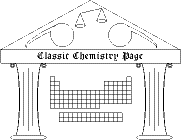Prout's hypothesis
William Prout advanced a hypothesis about atomic weights that had a lasting effect in chemistry far beyond the evidence on which it was based. Briefly, Prout noticed that a great many elements had atomic weights (combining weights, really) that were multiples of that of hydrogen, or very nearly so. He hypothesized that the atomic weights of all elements were indeed multiples of that of hydrogen. He speculated, furthermore, that hydrogen was some sort of "prime matter" from which other elements were composed.
1) The relative masses of gas molecules can be computed from gas densities. (After all, the density is the mass of a unit volume, and that volume contains the same number of molecules, whatever the gas, so a ratio of densities is the same as a ratio of molar masses.) Construct a table of relative molar masses based on the gas densities reported by Prout and using hydrogen as the unit molar mass. (The following densities were experimental results published by other scientists and quoted by Prout.)
| molecule | gas density (air = 1)
|
|---|
| hydrogen | 0.073
|
| azote | 0.969
|
| oxygen | 1.104
|
| chlorine | 2.483
|
2) Construct a table of relative molar masses based on the gas densities reported by Prout and using hydrogen as the unit molar mass. (The following densities were based on certain adjustments described by Prout in his paper.)
| molecule | gas density (air = 1)
|
|---|
| hydrogen | 0.06944
|
| azote | 0.9722
|
| oxygen | 1.1111
|
| chlorine | 2.5
|
3) Evaluate Prout's hypothesis in light of the experimental evidence available to him and his contemporaries (as represented by the table in exercise 1).
References
William Prout, "On the Relation between the Specific Gravities of Bodies in their Gaseous State and the Weights of their Atoms," Annals of Philosophy 6, 321-30 (1815); "Correction of a Mistake in the Essay on the Relation between the Specific Gravities of Bodies in their Gaseous State and the Weights of their Atoms," Annals of Philosophy 7, 111-3 (1816): both published anonymously
Copyright 2003 by Carmen Giunta. Permission is granted to reproduce for non-commercial educational purposes.

| Back to the top of the Classic Chemistry site |